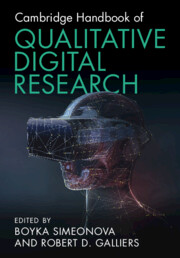Book contents
- Cambridge Handbook of Qualitative Digital Research
- Cambridge Handbook of Qualitative Digital Research
- Copyright page
- Contents
- Figures
- Tables
- Contributors
- Preface
- Part I Philosophical, Epistemological and Theoretical Considerations
- Part II Methodological Considerations
- Part III Illustrative Examples and Emergent Issues
- Chapter 13 Observing Artifacts
- Chapter 14 Algorithms as Co-Researchers
- Chapter 15 Sensemaking about HRV Data of High-Performing Individuals
- Chapter 16 The Rich Facets of Digital Trace Data
- Chapter 17 Balancing the Momentum of Datafication with Qualitative Researchers as Design Thinkers
- Chapter 18 What Data Sharing in Government Tells Us about the Digitalization of Government Services
- Index
- References
Chapter 15 - Sensemaking about HRV Data of High-Performing Individuals
Crafting a Mixed Methods Study
from Part III - Illustrative Examples and Emergent Issues
Published online by Cambridge University Press: 08 June 2023
- Cambridge Handbook of Qualitative Digital Research
- Cambridge Handbook of Qualitative Digital Research
- Copyright page
- Contents
- Figures
- Tables
- Contributors
- Preface
- Part I Philosophical, Epistemological and Theoretical Considerations
- Part II Methodological Considerations
- Part III Illustrative Examples and Emergent Issues
- Chapter 13 Observing Artifacts
- Chapter 14 Algorithms as Co-Researchers
- Chapter 15 Sensemaking about HRV Data of High-Performing Individuals
- Chapter 16 The Rich Facets of Digital Trace Data
- Chapter 17 Balancing the Momentum of Datafication with Qualitative Researchers as Design Thinkers
- Chapter 18 What Data Sharing in Government Tells Us about the Digitalization of Government Services
- Index
- References
Summary
In collaboration with the HR team of a large IT service provider, this chapter relates to a study of fifty individuals who have been identified as high performers by their employer and the search for indicators and patterns of sustainable high performance.
The research design consisted of initial interviews at a virtual day, attendance of 2.5-day off-site coaching workshops and up to 60-minute follow-up interviews. During the workshop days, 24-hour heart rate variability (HRV) measurements were collected – a well-established biomarker of well-being, strain and recovery. As HRV data are difficult to analyze without contextual information, interviews, focus-group sessions, participatory observation and debriefing interviews were combined in order to contextualize the quantitative measurements and involve the participants in the interpretation and sense-making of the findings.
The methodological goal of this chapter is to demonstrate how orchestrating, improvising and performing a mixed-method study has been essential to validate, augment and complement quantitative data. The study results depend on the ability of the researchers to skilfully and empathetically engage with the interviewees and to engage them as participants in the interpretation of their data and thus as co-producers of meaning.
Keywords
- Type
- Chapter
- Information
- Cambridge Handbook of Qualitative Digital Research , pp. 229 - 246Publisher: Cambridge University PressPrint publication year: 2023

